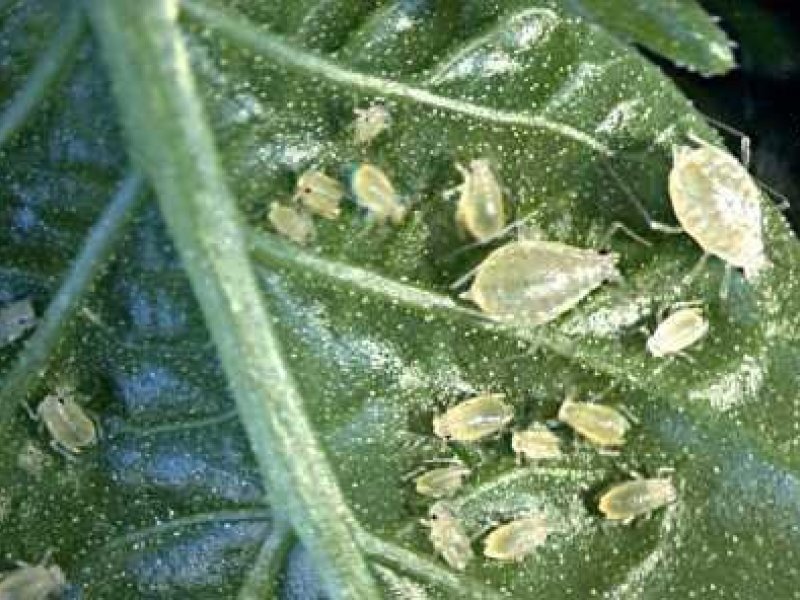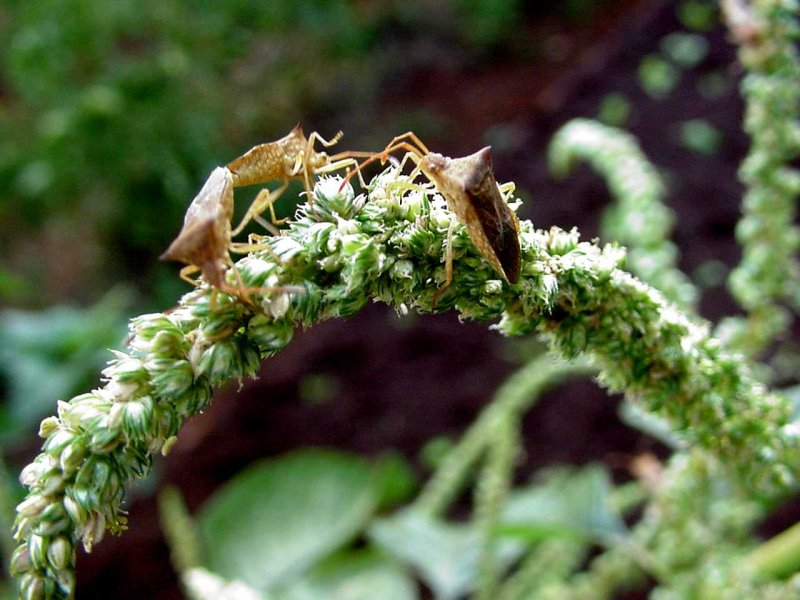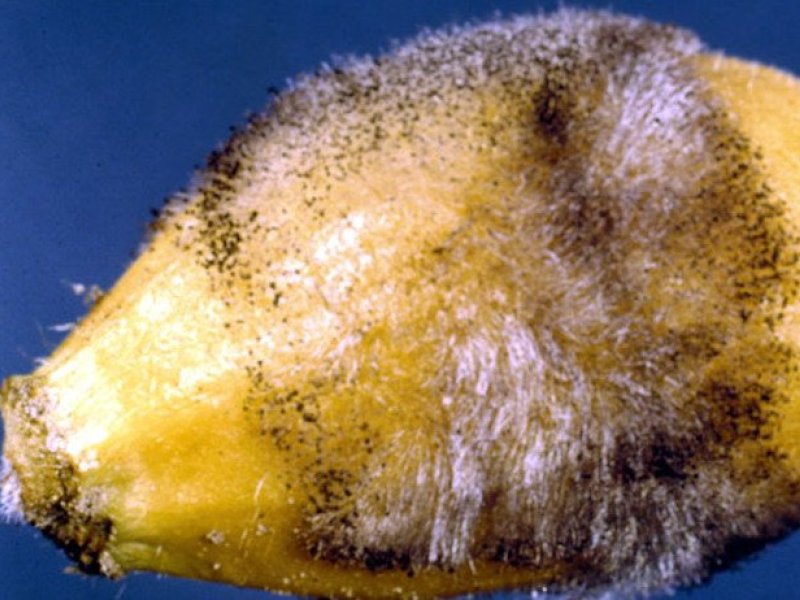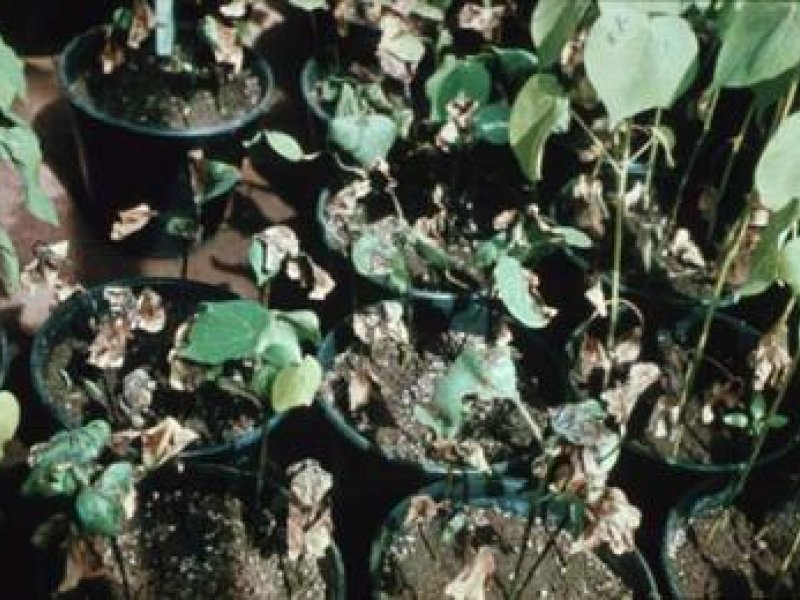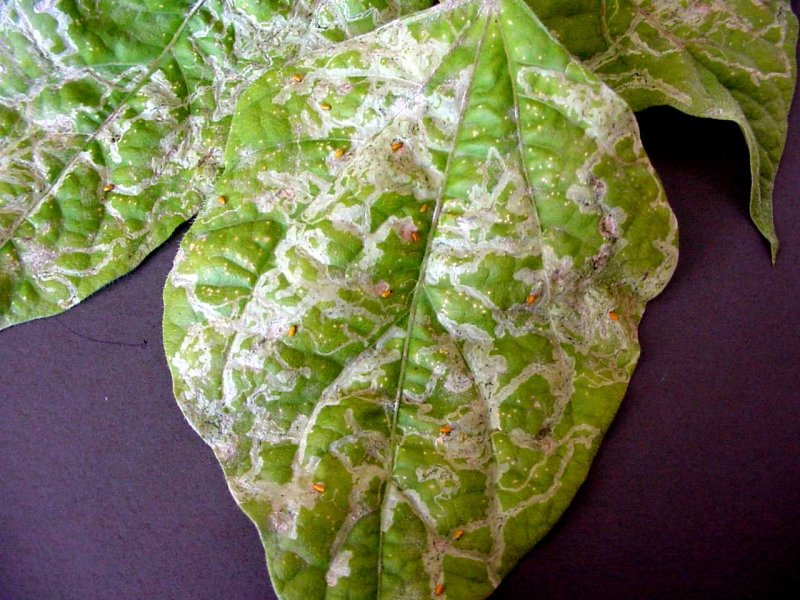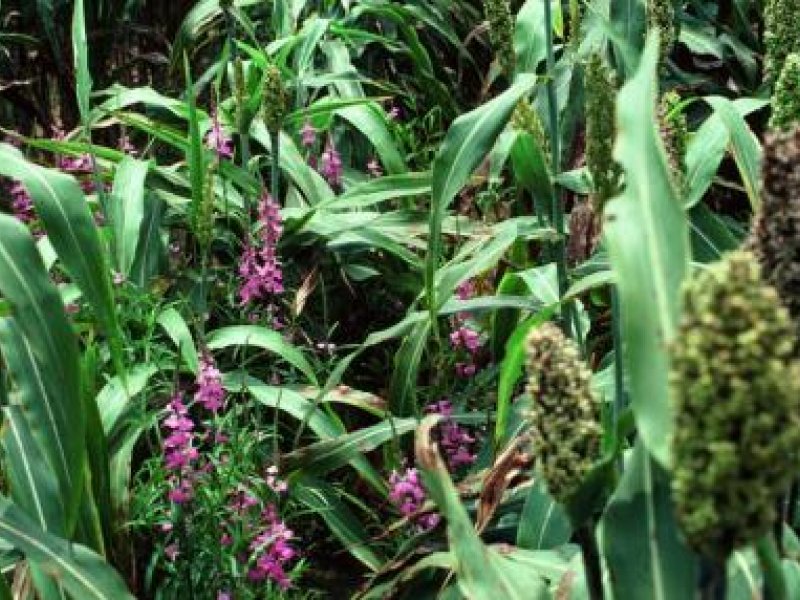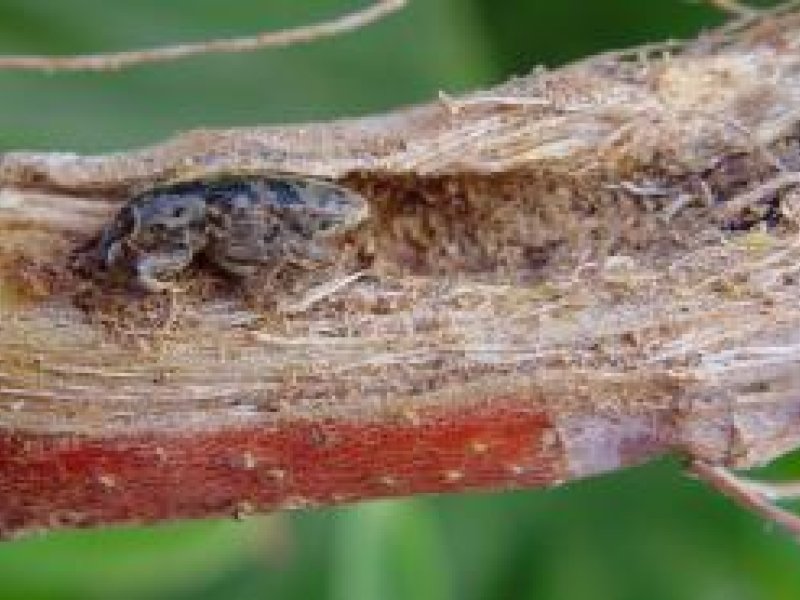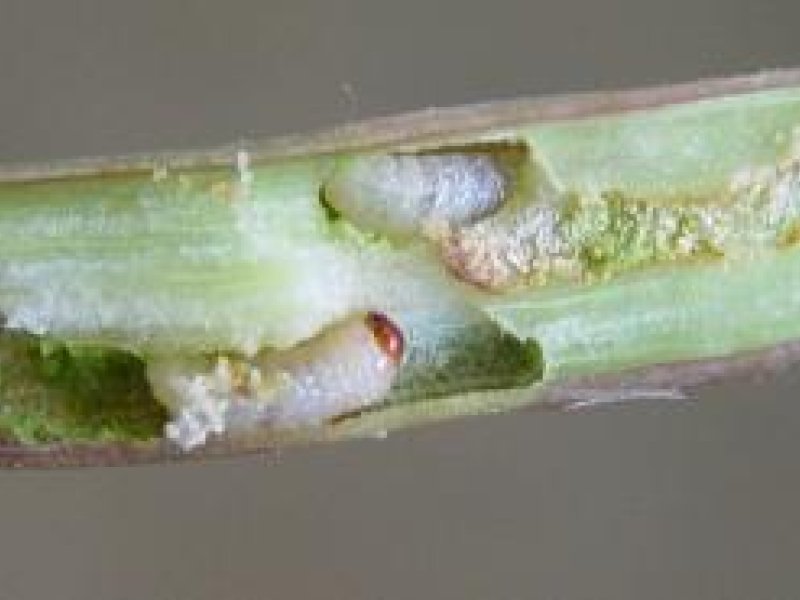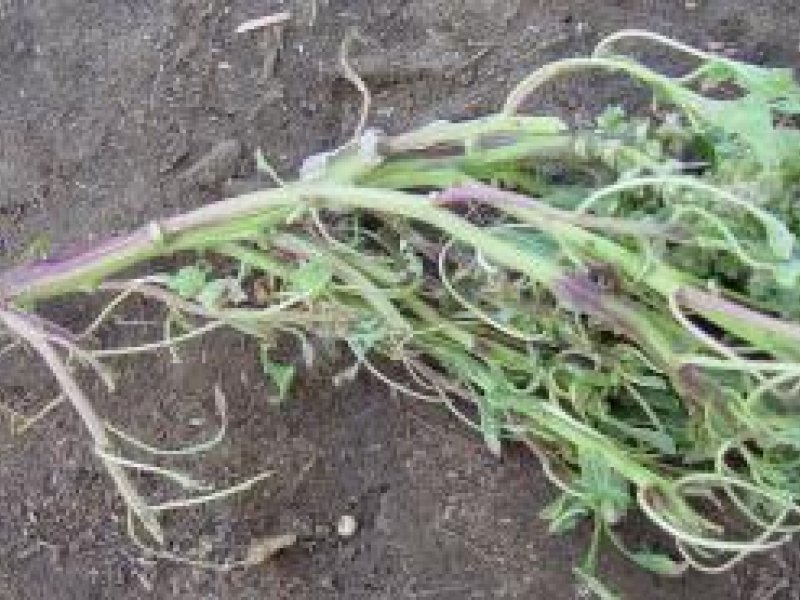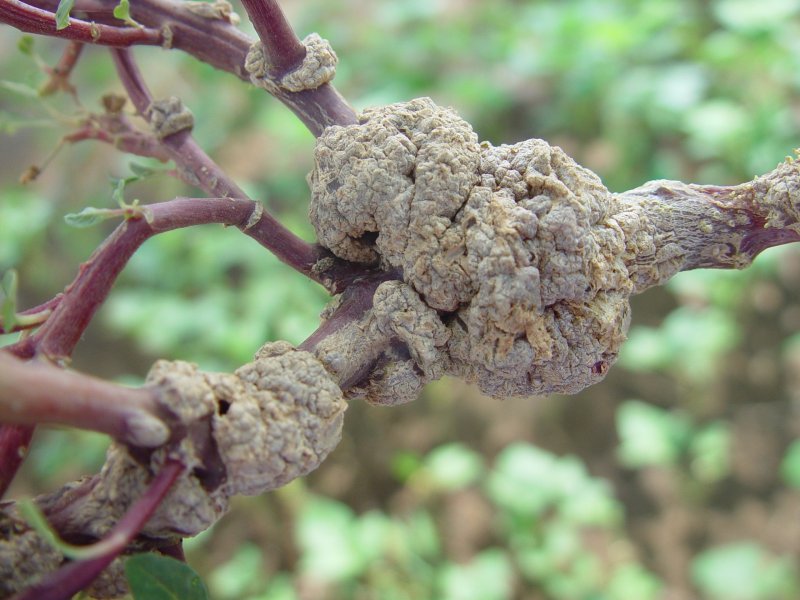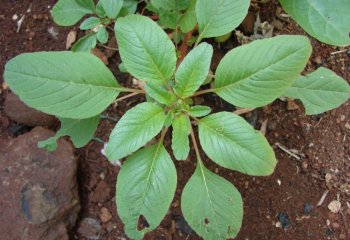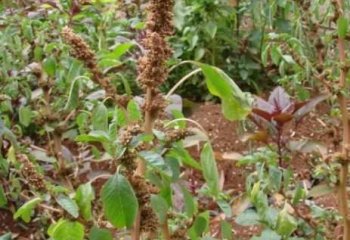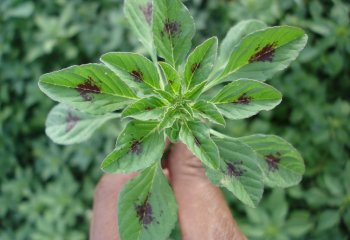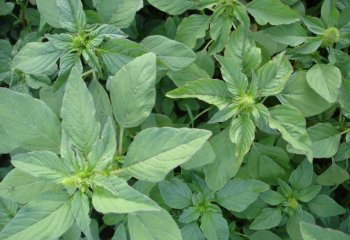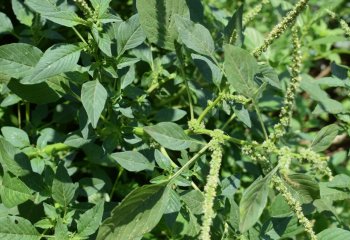|
Aphids (Aphis spp.) Aphids are a major pest, causing leaves to curl and become unattractive to customers. Aphids feed by sucking plant sap. Small aphid populations may be relatively harmless, but heavily infested plants usually have wrinkled leaves, stunted growth and deformed seeds. Plants, in particular young plants, may dry out and die under heavy aphid attack. Heavy attack on older plants may cause crop loss by decreasing flower and seed production. Damage may also reduce seed viability. |
|
|
What to do:
|
|
Bugs Bugs can cause severe damage to flowering head and seeds, and may be particularly damaging to grain amaranth when present in large numbers during the critical seed fill stage. They are usually of minor importance in vegetable amaranth, and no control measures are needed. |
|
|
What to do:
|
|
Choanephora rot Choanephora blight (also called Choanephora rot) is caused by fungus Choanephora cucurbitarium. It causes wet rot of stems and leaves. Affected plant parts have hairy appearance (silk-like threads) consisting of fungal spores. Infection is predisposed by injuries. During rainy season it can cause heavy defoliation. The disease is spread by air currents and infected seeds. Warm, moist conditions favour disease development. |
|
|
What to do:
|
|
Cutworms Cutworms attack young seedlings. First instars are 7-12mm, fully grown caterpillars are 3.5-5 cm long. The caterpillar emerges from the soil at night, encircles the plant with its body and cut through the stem of young plants just above ground level. They may also damage the plants underground. Cutworm damage causes plants to wilt and die. Cutworm damage is usually minor and does not normally warrant control. However, in severe outbreaks a young crop may be destroyed. |
|
|
What to do:
|
|
Damping-off diseases (Pythium spp. Rhizoctonia solani ) The disease is caused by Pythium aphanidermatum, Rhizoctonia solani and Aphanomyces sp. Seeds may rot in the soil before emergence (pre-emergence damping-off) or seedlings may exhibit stem canker above the soil line and/or root necrosis. Affected seedlings eventually wilt (post-emergence damping-off). The disease is favoured by high soil water content and low soil temperatures. Also dense planting without sufficient aeration enhances disease development. |
|
|
What to do:
|
|
Leafminers (Liriomyza spp.) Leafminers (Liriomyza spp.) are small flies, 1.3-1.6 mm in length. The maggot makes long, slender, white mines (tunnels) in leaves. Severely mined leaves may turn yellow and drop. Severely attacked seedlings are stunted and may eventually die. Control measures are necessary when attack is severe, especially on young plants. |
|
|
What to do:
|
|
Spider mites (Tetranychus spp., Mononychellus spp., Oligonychus spp.) Spider mites feeding on plants may cause reduction in plant growth, flowering, and number of seeds. Damage is most severe when mites attack young plants. Mite damage may be particularly severe during the dry season. |
|
|
What to do:
|
|
Weeds Weeds compete for light, water, and nutrients, thereby resulting in reduced yield. Thorough land preparation is the first key to effective weed control. Amaranth is small-seeded and slow to germinate - therefore, weed control is essential early in the season. A seedbed free of weed seeds allows amaranth seedlings to get a head start on the weeds and establish a canopy that can shade out emerging weed seedlings. |
|
|
What to do:
|
|
Weevils Several species of weevils feed on amaranth. Adult weevils feed on leaves, but the larvae (grubs) are more damaging because they bore into roots and stems, causing rotting and potentially lodging and predisposition to diseases. Stem-boring weevils such as the pigweed weevil (Hypolixus haerens) are the most damaging causing plants to wither and lodge. The adult weevil lays its eggs in branch crotches, and the larvae bore through stems to the root collar hollowing the stems. Feeding by larvae results in stems that are more susceptible to wind breakage, thus increasing crop losses. The larvae pupate in the stem. In South Africa, attack by this weevil has been associated with extensive tissue discolouration, decay and cankers in branches, stems, and root collars of Amaranthus hybridus. This weevil has been found to be associated with fungi (mainly Fusarium spp) that cause tissue decay and a canker disease (Blodgett et al., 2004). |
|
|
What to do:
|
Geographical Distribution in Africa
Map showing the Geographical Distribution of Amaranth Crop in Africa. Source www.cabi.org (2014). Updated 28 November 2018.
Read more
Botswana: Thepe (A. thunbergii), Mbowa (Shona) (A. thunbergii) (Chweya & Eyzaguirre, 1999)
Burkina Faso: Bamambourou (Dagara) (Amaranthus cruentus) (Maundu P. et al., 2015)
Cameroon: Kumkum (Bafia), Ndjap mekat (Bamileke), Feufe (West Province), Teue (Bamoun), Po’oga (Bassa), Folong (Bulu, Ewondo), Biwolè (Littoral Region), Agnaka/ Hakondjam (Fulfudé), Gagnorwa (Haoussa), Kumkuma (Eton) (Chagomoka et al., 2014); Green, Epore, Mewahge, Efieh, Keliangiie, Hayeka Bewole, Pouko (IPGRI, 2006).
Democratic Republic of the Congo: Dunda (Lingala) (IPGRI, 2006); Kpedekpede (Mbuti Pygmies, Ituri forest) (A tricolor) (Hideaki, 2003)
Ethiopia: Tsunata (Berta), (A. hybridus); Horoqota (Darashe) (A. graecizans); Amugnaeder (Anuak) (A. spinosus) (Lulekal et al., 2011); Yekchanchila (Gumuz) (Amaranthus cruentus) (Maundu P. et al., 2015)
Ghana: Alefi (Krobo), Srahansoe, Nantwibin, Nantwinkasee, (Twi/Akan), Awsaumei, Dan, Anago mio (Ga), Asibe (Asantewa), Aleefu (Krobo/Ga Adangbe), Matonui, Moxeti, Senutsoe, Fotete, Awusagbe (Ewe) (A. cruentus) (Nyadanu & Lowor, 2015)
Kenya: Edodo, Emboka, Litoto (Bukusu), Chiswenya, (Chonyi, Digo, Kambe); Kiswenya, Kiswenya-Kithithe (small form) (Giriama); Raprapa, I-Okuronit, I-Okuroniti (Ilchamus); W'oa, Telele (Kitui), Terere (Mwingi) (Kamba); Chepkerte, Chepkerta (Keiyo); Terere (Kikuyu); Kelichot (Kipsigis), Emboga (Kisii), Tsimboga, Edodo, Litoto (Plant), Omboga (Luhya), Tsimboga (Maragoli)), Ododo, Omboga (Luo), Nanyi, Nyanyi (Maasai), Kipkanding'wa (Marakwet), Terere (Mbeere), Terere, Rwoga (Meru), Nyoni, Ntererei, Mir (Samburu), Kiswenya (Sanya), Dargo Sagar, Daargo-Warabe (Somali), Mchicha (Swahili), Lidodo, Litoto (Tachoni, Marachi), Kichanya, Kizenya (Taita), Eboga (Teso), Terere (Tharaka) (Amaranthus Spp.); Mborochet, Mborochik (Kipsigis), Libokoyi (Luhya) (A. Blitum); Cheptokdogan (Kipsigis), Tsimboka Tsia Navanyolo (Luhya (Kisa)), Enyaru-Olmuaate, Enyaru-Nanyokie (Maasai), Chepkerte, Chepkarta (Marakwet) (A. Cruentus, A. Hybridus); Rwoga (Embu), Logatsi (Giriama), W'oa (Kamba), Terere Wa Gikuyu (Kikuyu), Ombok-Alikra (Luo), Kipkanding'wa, Kipiriak (Plural) (Marakwet), Muruoga (Mbeere), Rwoga Ra Kicuka (Meru), Ptanya (Pokot), Dargu (Somali), Rwoga (Tharaka), Ekiliton, Lokiliton, Louyeing'orok, Adye (Turkana) (A. Graecizans); Kiswenya-Cha-Miya (Giriama), Lkamasei (Ilchamus), Terere-Wa-Ng'ombe, Terere Wa Kigombe (Kikuyu), Mborochet (Kipsigis), Sikukuu, Chepkuratian (Pokot), Nairepirepi (Samburu), Kiswenya-Korati (Sanya), Lookwa, Epespes (Turkana) (A. Spinosus). (Maundu et al., 1999)
Madagascar: Anampatsy (A spinosus) (Nový, J. 1997); Agnambario, Agnampatsy (Antakarana), Anamena, Anampatsa, Kimoelahy, Sabotraboay (Malgache), Amarante Épineuse, Épinard Malabar, Épinard Piquant (French) (A. spinosus) ; Antakaranaagnambario (Antakarana), Anantarika (Malgache), Amarante Fournaise, Amarante Tête D’éléphant, Amarante Tricolore, Épinard Chinois (French) (A. tricolor) (Nicolas & Allorge-Boiteau, 2012)
Malawi: Bonongwe (Chewa) (A. viridis, A. dubius, A. hybridus) (Morris, B., 1996)
Mozambique: Tzeke (Maputo) (A. spinosus) (Slow food, 2015)
Nigeria: Tete abalaye (Yoruba) (A. viridis); Dagunro (Yoruba) (A. spinosus) (Faluyi., 2020); Tete (Yoruba), Opotoko (Igbo) (A spinosus) (Aiyeloja and Bello, 2006); Inine (Ibo), Tete Elegun (Yoruba) (A spinosus) (Egharevba & Ikhatua, 2008)
Senegal: Mboro-mboro, Mbuumi ker (Wolof, Pulaar), Daxdiir (Sereer) (A. hybridus ssp. incurvatus, A. viridis); Daxdiir gor (Sereer) (A. spinosus); Mbuum bu gor (Wolof) (Chweya & Eyzaguirre, 1999
South Africa: Meerjarige misbredie (A. deflexus); Hanekam (Afrikaans), Thepe (Sotho), Imbuya (Zulu), Vowa (Venda) (A. hybridus, A. hypochondriacus) (DAFF., 2010); Mukango (A. cruentus) (Constant & Tshisikhawe, 2018); Misbredie, Hanekam, Varkbossie (Afrikaans), Unomdlomboyi, Imbuya, Umifino umtyuthu (Xhosa), Imbuya, Isheke, Indwabaza (Zulu), Thepe, Theepe (Pedi, Sotho, Tswana), Umbuya, Isheke (Swati), Vowa, Theebe (Venda), Theyke, Cheke (Tsonga), Mohwa (Shona), Imbuya, Tyutu (Pondo) (Van Rensburg et al., 2009); Misbredie (Afrikaans), (A. hybridus); Perennial Amaranth (English) (A. deflexus); Cape amaranth (English) (A. hybridus); Thorny Amaranth (English) (A. spinosus); Red amaranth (English) (A. thunbergii). (Dorado et al., 1999)
Sudan: Lisan elteer (Arabic) (Amaranthus spp.) (Ahmed K, M & Mohammed l.E, 1997).
Tanzania: Mchicha (Swahili); Mochicho (Mbugwe), Bwache (Sambaa) (Amaranthus spp.); Buuza, Bwache, Bwache-katonge (Bondei), Kiyana kya mburu (Chagga), Chamilangíuku, Lichamilangíuku, Lifweni (Hehe), Kapokole, Ntungu (Nyamwezi), Buruja (Pare), Bwache (Sambaa), Bwache (Zigua) (A. spinosus). (Ruffo et al., 2002)
Togo: Boboroa (Gurma) (A. viridis) (Burkill,1985); Gbetongwi, Essogbé, Amatonui (Ewé) (A. spinosus) (Adjanohoun et al., 1986)
Uganda: Nyamujogo (Adhola), Edodo (Ateso), Obuga (Luganda), Doodo (Langi, Lugbara), Doodo (Lugwe), Doodo (Lugwere), Doodo (Lusoga), Onyoko (Madi), Acuka, Lomusgui (Ngakarimojong), Doodo (Runyankore), Doodo (Runyoro), Doodo (Rutoro) (A. dubius);, Doodo samba (Adhola), Goyi, Goi (Alur), Eboga lapolon (Ateso), Gbedegbede (Kakwa), Obuga munu (Langi), Goyi (Lugbara), Liwola (Lugisu), Lomusugui (Ngakarimojong), Omuriri (Rukiga), Omuriri (Ranyankore), Doodo enjungu (Runyoro) (A. hybridus);, Mboog’ennene (Luganda), Nyabutongo (Rukiga), Omuriri, Nyabutongo (Runyankore), Bwora, Doodo (Runyoro) (A. lividus) (Katende et al., 1999)
Zimbabwe: Bonongwe (Shona), Imbuya (Ndebele), Mbowa (Shona), Mowa (Shona), Teka (Hlengwe) Umbhida (Ndebele) (A. thunbergii) (Hyde, et al., 2021); Mowa nguru, Mowa rine minzwa, Mowa risina minzwa (Mashonaland), Imbuya dhongi, Imbuya mbuya, Imbuya ncane (Matembeleland) (Chweya & Eyzaguirre, 1999)
Introduction
Amaranths are among Africa's most popular and most nutritious leafy vegetables. Some are also an important source of nutritious grain. Amaranths consist of 60–70 species worldwide, many of which have edible leaves. About a dozen species are important in Africa, as leafy vegetables, grain and ornamentals. Many species are originally from tropical America. Although several species are often considered weeds, the tender shoots and leaves are harvested in both wild and crop fields and are increasingly being cultivated for both home consumption and markets. Amaranth is a promising crop mainly due to its tolerance to heat, pests and diseases and the high nutritional value of both seeds and leaves.
Amaranth is a nutritious plant rich in micronutrients. The leaves are often cooked with coarser vegetables like cowpeas to soften them or bitter vegetables, such as spider plants, African nightshades and bitter lettuce to modulate their flavour. In dry regions, the leaves are dried and ground to powder for us in sauces during the dry season. Amaranth grains are also considered a good source of essential minerals like calcium, magnesium, iron, and zinc. The grains are mainly obtained from Amaranthus hypochondriacus and some forms of A. cruentus. The seeds may be made into pop-cereal or milled to make flour that is incorporated into various products such as cereal flours. In Ethiopia, the grains are used in brewing alcoholic beverages.
While amaranths are not commonly used as medicine, some of the species have been used to treat various ailments in traditional medicine. Some forms of amaranths can also be used to produce yellow and red dyes for coloring foods and medicines. Some types, like Amaranthus tricolor are also grown as ornamentals because they have big, bright red leaves and flowers.
(Source: Maundu et al., 2009, Grubben and Denton, 2004, Ebert et al., 2011, Trucco and Tranel, 2011, Schippers, 2000; Van Wyk and Gericke,
2000; Rensburg et al., 2004).
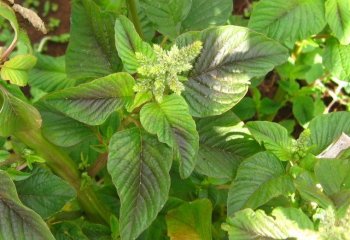 ⒸA.A. Seif |
General Information (Species account and Ecological information)
Varieties
The genus Amaranthus, commonly known as the amaranths, is a resilient group of plants distributed widely throughout Africa. Members can be found in various habitats, including cultivated fields, disturbed areas and the wild. With over a dozen species occurring in Africa, some are native to the continent, while the majority have been introduced from other regions, particularly the Americas. Some native species such as A. sphaganiocephalus (Maasai amaranth), found in East Africa, have a limited distribution. On the other hand, some introduced species like A. cruentus are more aggressive and have a wider distribution.
Most members of the genus Amaranthus that are found in Africa have monoecious flowers, meaning that individual flowers can be either male or female, but both sexes are found on the same plant. The flowers are primarily wind-pollinated, contributing to their wide distribution in different habitats. The following are the main amaranth species used in Africa.
1. Amaranthus blitum probably originated is tropical Africa and the Mediterranean region. It is naturalized in other parts of the world, from the tropics to temperate climates. In Africa, it is found in many countries with humid or sub-humid climate, mainly from mid to high altitudes. It occurs in cultivation and less often in the wild. It is cultivated in Central Africa (Cameroon) and East Africa (Kenya (Nyanza, South Rift and Western regions), Uganda and Tanzania).
2. Amaranthus caudatus originated from the central and northern Andes. It had long been grown as a food crop in the Andes, e.g., by the Incas, and the most significant genetic variation occurs in this area (Ecuador, Peru, Bolivia, and Argentina). In Africa, the distribution of A. caudatus is less documented as it has often been confused with other amaranthus species. The brightly colored types are often grown as ornamentals, mainly outside Africa.
3. Amaranthus cruentus is widespread in tropical Africa. It is originally from Central America and Mexico. It is a major leafy vegetable in parts of West Africa (southern Nigeria, Benin, Togo, and Sierra Leone) and in Central and East Africa. Grain types of A. cruentus are common in Central America and northern South America, India and Nepal but also commercially grown warmer, drier areas of the United States, Argentina, and China.
4. Amaranthus deflexus or deflexed amaranth (meaning bent downwards) is uncommon in the region but has been sighted particularly in Southern Africa. It is originally from South America.
5. Amaranthus dubius is widespread throughout most warm, humid, and sub-humid tropical Africa. It originates from tropical America, where it is common in the Caribbean region and from southern Mexico to northern South America. The cultivated type may have been developed from a weedy ancestor in tropical Asia (Indonesia, India). Amaranthus dubius is widely cultivated in West, Central, East, and Southern Africa. It is particularly important on the east coast of Africa, where it grows spontaneously in crop fields and is preserved for use as a vegetable.
6. Amaranthus graecizans occurs naturally throughout tropical Africa in sub-humid and dry areas. It is also distributed in southern Europe, tropical and subtropical Asia and was introduced to the United States. It is mainly collected in the wild as a vegetable in parts of Kenya, Uganda, Tanzania, Malawi, and elsewhere in southern Africa. It is especially popular shortly after the start of the rainy season before seeds develop. It is locally cultivated on a small scale in home gardens, e.g., by the Acholi people in Nebbi, Uganda, and in parts of Tanzania for the market.
7. Amaranthus hybridus sub-species hybridus is common in mid to high altitudes in Africa. It is common in crop fields.
8. Amaranthus hypochondriacus originates from central Mexico. It is now widely cultivated worldwide, including in tropical Africa, where it is mainly grown for its vegetable and grain.
9. Amaranthus retroflexus is only occasional in parts of Africa. The red-rooted Amaranth, as it is commonly called, is native to North America. The inflorescence has a spiny appearance like that of A. hybridus spp. hybridus.
10. Amaranthus sparganiocephalus is found in semi-arid to semi-humid areas of Eastern Africa and the Arabian Peninsula. It is common in mid-altitudes.
11. Amaranthus spinosus probably originated from tropical South and Central America but is now widely distributed in the warmer parts of the world, including tropical Africa, where it mainly occurs as a weed and in disturbed open places. It is not normally cultivated, but in crop fields, a few plants may occasionally be preserved as a source of vegetables.
12. Amaranthus thunbergii is native to Southern Africa but grows as far north as the Congo and the Horn of Africa. It mainly occurs in open places in the wild but also as a weed in cultivated land. It is now found as a weed in Australia and Europe.
13. Amaranthus tricolor originates from tropical Asia, where it is one of the important leaf vegetables. A. tricolor is not a competitive weed and therefore it is a rare exotic vegetable in Africa. It is occasionally cultivated in cities as an ornamental.
14. Amaranthus viridis is possibly of Asian origin but is now a cosmopolitan weed in the tropics and subtropics of the world. In tropical Africa, it is common in cities and roadsides. It is occasional in crop fields.
(Sources: Maundu, P. 1999; Ebert, A, W, 2011; Grubben and Denton, 2004; Achigan et al., 2014; Ebert, A.W., 2011).
Species accounts
Amaranths are often challenging to identify taxonomically due to their close resemblance and the presence of intermediaries. The small seeds are easy dispersed and so species may often occur where they are not expected. Easy morphological features to check include plant growth habit, stem and leaf coloration, mature plant height, the shape of the leaves and the inflorescence. The seeds are usually shiny black or brown but may be cream in edible grain types. The following are some of the more common amaranths.
Amaranthus blitum is a branched, erect, ascending or prostrate herb that grows to nearly 1.2 m in height, but usually smaller, around 30–60 cm, in cultivation. Its stems are usually green to brown, occasionally reddish in color. The leaves are typically green, sometimes with a slight brown tinge. The flowers are borne in axillary and terminal spikes. The seeds are conspicuously larger compared to other species of amaranth, with approximately 100 seeds per gram.
A. blitum is used as a leaf vegetable in many African countries. It is highly regarded for its soft texture. It is often recommended for young children, lactating mothers and people who are anaemic. The plants are eaten by livestock but sparingly.
(Sources: Maundu et al., 1999; Burkill, 1985; Achigan et al., 2014; Grubben & Denton, 2004).
|
Ⓒ Maundu, 2012 |
Ⓒ Maundu, 2019 |
Amaranthus cruentus is an annual herb grown for grain production (pseudocereal), as well as a leafy vegetable and ornamental. The plant can grow to a height of 1-1.5 m high, sometimes even higher. The crop is characterized by its fast growth, ribbed, straight stems, large pointed leaves, and a conspicuous terminal inflorescence with a prickly appearance. The inflorescence may vary in color from green to red or purple and sometimes a mixture of these colours. The seeds are usually dark brown to black, but can also be white to cream or golden in grain amaranths. Ornamental types of A. cruentus have large bright-red inflorescences and are often found in the tropics and subtropics. These inflorescences can be used to produce a red dye. In tropical Africa, A. cruentus is grown as a highly productive, nutritious and economically important leafy vegetable. The young leaves and tender stems are commonly harvested and cooked or fried, and served as a side dish.
(Achigan et al., 2014, Maundu, 1999; Grubben and Denton, 2004; Wolosik et al., 2019. Chaney, 2021; Ebert, A.W., 2011).
|
|
|
Amaranthus dubius is an erect herb that grows to a height of 1 m or more. The stems are ridged, highly branched, and usually green or tinged purple. The leaves are simple, usually with an ovate leaf blade to 8 cm long, veins conspicuous underneath. The flowers are borne in clusters, in the axils and in terminal branched heads or spikes. Fruits are covered by bracts and bracteoles which are the more visible structures of the flowering part. Seeds black, shiny.
The leaves and tender shoots are used as vegetable, sometimes cooked with more bitter vegetables such as spiderplant, african nightshade and bitter lettuce. The plant is grown commercially for city markets, especially in East Africa. This species is now widely grown for its leaves and is also a common plant in disturbed areas, cities, and riverine environments
Used for children and lactating mothers, treating fever, hemorrhage, anemia and stomach ache.
(Grubben and Denton, 2004; Schippers, 2000, Maundu, P.M, 1999, Achigan et al., 2014)
|
|
|
A. graecizans: Is an erect, decumbent or prostrate herb usually branched from the base and often less than 40 cm high. The leaves are small. Inflorescences are green and born in clusters on the leaf axils. The seeds are tiny, smooth and shiny black.
The leaves and the young tender leaves are used as vegetable. One significant limitation is that the leaves of this species are small, and gathering a sufficient quantity for a meal is laborious and time consuming. The vegetable is often mixed with other vegetable leaves and may also be mashed with a mixture of maize and pulse among the Kamba and Kikuyu . The seed is baked into thin cakes while in some countries it is ground into flour. In East and West Africa, the plant is used to manufacture local salt.
(Maundu et., al., 1999, Maundu, P.M. & Grubben, 2004, Grubben and Denton, 2004;).
|
|
|
A. hypochondriacus is an annual herb growing to 2m tall or more. .Its large inflorescence is often dense and varies in colors from red to dull yellow to green. The stem is stout, and the branches are angular. The fruit is ovoid to rhombic capsule. The seeds are whitish to yellowish or blackish.
A hypochondriacus is used as a potherb, and the seed is a grain (South and Central America and Asia). The seed is pooped, roasted, or milled like maize; used to make bread in India, while in Africa, it is grown as an ornamental; recommended as a health food; it has antioxidant properties.
(Schippers, 2000, Grubben and Denton, 2004, Achigan et al., 2014).
A. hybridus Is an erect or prostrate branched herb usually 40-80 cm but occasionally attaining the height of 100 cm, especially in cultivation. The stems are green or tinted red and ridged. The leaves are simple alternate, green or tinted red. The flowers may be yellowish, green, reddish, or purple At maturity, and the entire plant may be reddish. Seeds are round, shiny black or cream. The leaves and young shoots are used as vegetable. The species is the commonest and the most widely used in the wetter regions. Much of it is picked from the wild or occasionally spared when found growing as a weed. (Maundu et., al., 1999).
|
|
|
A.spinosus: commonly known as spiny Amaranth, is a stout (occasionally decumbent) herb that grows to a height of about 1 m. The stems are angular, green, that may have a purple hue. It bears small green flowers that are grouped in clusters and have spines. The seeds are smooth, shiny, and reddish brown.
In tropical Africa and other regions, A. spinosus is seldom used as a leafy vegetable, picked mostly while still young before the spines have hardened. The leaves are occasionally sold in markets in Uganda and Kenya, but command a lower price than, for example, A. dubius because of its spines and unpopularity. Its use as vegetable is declining, and it is considered a food of last resort during famines.
A. spinosus is also used as forage and is said to increase milk yield in cattle. However, the spines can cause injury to the mouths of grazing animals. In Uganda, the ash of burnt A. spinosus plants is used as a tenderizer in cooking coarse vegetables and as a vegetable salt in southern Africa.
A. spinosus has numerous medicinal applications. Its root is known for its diuretic properties and is used as a decoction to treat gonorrhea in South-East Asia, The bruised leaves are considered an effective emollient in many African countries and elsewhere, and are applied externally to treat conditions such as eczema, burns, wounds, boils, earache, and hemorrhoids. When the plant's ash is mixed with Water, it is used to wash sores. A. spinosus sap is also used as an eye wash to treat ophthalmia and convulsions in children.
(P Maundu, 1999a, Jansen, P.C.M., 2004, plant@net, 2022)
|
|
|
A. thunbergii (Thunberg's Amaranth) is a small annual erect or ascending herb that grows to a height of about 50 cm tall. The stem can be simple or branched, angular, and almost hairless below but usually with long multicellular hairs towards the top. Flowers are unisexual and greenish in short axillary clusters. This plant is essential in Botswana, Namibia, and South Africa, where it is commonly consumed fresh or dried.
Leaves of this plant have a slightly bitter taste compared to other amaranth species. The vegetable can be eaten fresh or dried with milk or fat in combinations with maize or sorghum. The plant is also used as fodder for livestock, the ground and dried flower heads are used to make tobacco snuff milder.
(Hyde et., al, 2021, Grubben and Denton, 2004).
A. tricolor (Joseph's Coat) is a vibrant annual herb that grows to a height of 1.2 m. The plant has a sturdy, angular stem that is often highly branched. The leaves vary in color from green and purple, and in some cultivars, the foliage can be a striking combination of brilliant yellow, red, pink, or copper. The seeds are brown. The leaves are commonly cooked and cooked as a leafy vegetable, the leaves and soft stems are also eaten raw with salads. A tricolor is also used as an ornamental and the treatment of inflammations and internally as a diuretic.
(Grubben and Denton, 2004; Schippers, 2002).
A. viridis is an erect annual or short-lived perennial herb that typically grows to a height 0.5 m. Its stems are slender, branched, and angular. A viridis is considered a pan-tropical weed and has penetrated warm temperate regions worldwide. It is also a widespread weed in Africa and is occasionally cultivated. Although mostly grown as a weed, its nutritional value is high. Leaves and young plants are eaten as cooked vegetables. The plant also serves as fodder for cattle and green manure. In traditional medicine, the leaves are highly regarded for their diuretic and purgative properties, and they are used to treat a variety of ailments. (Ebert, A, W, 2011, Grubben and Denton, 2004).
|
Ⓒ P. Maundu, 2021 |
Ecological information
The different species of amaranths have different altitude ranges of occurrence, with upper limit of below 2600 m. Leafy amaranths thrive in warm temperatures above 25ºC. Seeds may fail to germinate below 15ºC.
When grown under irrigation, frequent irrigation is required. The plant can tolerate drought periods once they are established, and they prefer fertile, well-drained soils that are loose and plenty of sunlight. Loam or salty-loam soils with high organic matter and good water-holding capacity are ideal for amaranths. Amaranth can tolerate a soil pH as low as 4.5.
(AVRDC, 2006, Bruce French, EcoPort).
Nutritional value information, complimentary recipes
Nutritive Value per 100 g of edible Portion
Amaranth leaves are a nutritious green leafy vegetable low in calories and fat. They are rich in essential minerals and nutrients, making them an excellent addition to a healthy diet. Amaranth leaves are an excellent source of calcium, iron, magnesium, potassium, and dietary fiber, essential for building and maintaining strong bones and teeth, regulating heart rhythm, supporting the immune system, maintaining a healthy digestive system, and preventing constipation. Additionally, amaranth leaves are a good source of antioxidants, including β-carotene equivalent and vitamin C, which help protect cells from damage, support the immune system, and aid in iron absorption.
| Raw or Cooked Grain | Food Energy(Calories / % Daily Value*) | Carbohydrates(g / %DV) | Fat(g / %DV) | Protein(g / %DV) | Calcium(g / %DV) | Phosphorus(mg / %DV) | Iron(mg / %DV) | Potassium(mg / %DV) |
| Amaranth grain cooked | 102 / 5% | 18.7 / 6% | 1.6 / 2% | 3.8 / 8% | 47.0 / 5% | 148 / 15% | 2.1 / 12% | 135 / 4% |
| Raw or Cooked Grain | Vitamin A(mg / %DV) | Vitamin C(mg / %DV) | Vitamin B6(mg / %DV) | Vitamin B12(mg / %DV) | Thiamine(mg / %DV) | Riboflavin(mg / %DV) | Ash(g / %DV) |
| Amaranth grain cooked | - | - | 0.1 / 6% | - | 0.0 / 1% | 0.0 / 1% | 0.8 |
|
Proximate composition and dietary energy |
|
Recommended daily allowance (approx.) for adultsa |
|
Energy (Kcal) |
36 |
2,300 |
|
Water (g) |
84.6 |
2000-3000c |
|
Protein (g) |
3.7 |
50 |
|
Fat (g) |
0.2 |
<30(male), <20 (female)b |
|
Carbohydrates (g) |
1.3 |
225 -325g |
|
Fibre (g) |
7.2 |
30d |
|
Ash (g) |
3.1 |
|
|
|
||
|
|
|
|
|
Mineral composition |
|
|
|
Ca (mg) |
150- 410 |
800 |
|
Fe (mg) |
6.8 |
14 |
|
Mg (mg) |
122 |
300 |
|
P (mg) |
89 |
800 |
|
K (mg) |
597 |
4,700f |
|
Na (mg) |
18 |
<2300e |
|
Zn (mg) |
0.92 |
15 |
|
Se (mg) |
22 |
60 |
|
Cu (mg) |
0.29 |
900c |
|
|
|
|
|
Bioactive compounds composition |
|
|
|
Vit A-RAE (mcg) |
326 |
800 |
|
Vit A RE (mcg) |
652 |
800 |
|
β-carotene equivalent (mcg) |
3,913 |
|
|
Vit E (mg) |
0.44 |
15g (19 for lactating mothers) |
|
Thiamin (mg) |
0.03 |
1.4 |
|
Riboflavin (mg) |
0.22 |
1.6 |
|
Niacin (mg) |
0.69 |
18 |
|
Vit B6 (mg) |
0.21 |
1.3c |
|
Folate (mcg) |
64 |
400f |
|
Vit C (mg) |
77 |
60 |
Source (Nutrient data): FAO/Government of Kenya. 2018. Kenya Food Composition Tables. Nairobi, 254 pp. http://www.fao.org/3/I9120EN/i9120en.pdf
RE=retinol equivalents.
RAE =Retinol activity equivalents. A RAE is defined as 1μg all-trans-retinol, 12μg beta-carotene, or 24μg α-carotene or β-cryptoxanthin.
*The specific species of amaranths used for analysis are unknown.
$ Draining the water several times leaches away water soluble nutrients significantly.
a Lewis, J. 2019. Codex nutrient reference values. Rome. FAO and WHO
b NHS (refers to saturated fat)
c https://www.hsph.harvard.edu/nutritionsource/water/
d British Heart Foundation
e FDA
f NIH
g Mayo Clinic
Amaranth grain (pseudocereal) is essentially rich in protein (all nine essential amino acids), manganese, magnesium, phosphorus, vitamins A and C, iron, fiber and antioxidants. The amaranth grains have been linked to numerous health benefits, including reduced inflammation, decreased cholesterol levels, weight loss, and improved brain function.
Table 2: Nutritional value of 100 g of Amaranth whole grain, dry and raw grains
|
Proximate composition and dietary energy |
|
Recommended daily allowance (approx.) for adultsa |
|
Energy (kcal) |
360 |
2,300 |
|
Water (g) |
10 |
2000-3000c |
|
Protein (g) |
14.7 |
50 |
|
Fat (g) |
5.6 |
<30(male), <20 (female)b |
|
Carbohydrates (g) |
59.2 |
225 -325g |
|
Fibre (g) |
7.5 |
30d |
|
Ash (g) |
3.1 |
|
|
|
|
|
|
Mineral composition |
|
|
|
Ca (mg) |
162 |
800 |
|
Fe (mg) |
9.5 |
14 |
|
Mg (mg) |
270 |
300 |
|
P (mg) |
397 |
800 |
|
K (mg) |
413 |
4,700f |
|
Na (mg) |
3 |
<2300e |
|
Zn (mg) |
2.5 |
15 |
|
Se (mcg) |
21 |
60 |
|
Bioactive compound composition |
|
|
|
Vit A-RAE (mcg) |
|
800 |
|
Vit A RE (mcg) |
|
800 |
|
β-carotene equivalent (mcg) |
|
|
|
Thiamin (mg) |
0.07 |
1.4 |
|
Riboflavin (mg) |
0.21 |
1.6 |
|
Niacin (mg) |
0.5 |
18 |
|
Folate (mcg) |
82 |
400f |
|
Vit C (mg) |
1 |
60 |
Source (Nutrient data): FAO/Government of Kenya. 2018. Kenya Food Composition Tables. Nairobi, 254 pp. http://www.fao.org/3/I9120EN/i9120en.pdf
Complimentary recipes
a. Amaranth leaves (Biteku teku) stew recipe (
Serves 4
Ingredients
• 1 kg of amaranth leaves (chopped)
• 15 green onions (chopped)
• 1 Onion
• 1 medium tomato (chopped)
• ½ cup of mint leaves (chopped)
• ½ yellow pepper (chopped)
• 1 yellow habanero pepper
• ½ cup of palm oil
• ½ tsp of salt
• 2 cups of Water
Preparations
1. Wash the soft leafy branches thoroughly in a colander (perforated bowl).
2. Chop the soft leafy shoots of the Amaranth thinly. Discard the hard stems. Put the leaves in a saucepan.
3. Add Water and put it on a medium-high fire on a stove.
4. Add the onion, green onions, tomato, mint leaves, pepper (e.g., habanero pepper), palm oil, and salt.
5. Do not stir at first.
6. After 5 min, mix everything well.
7. Let it boil for 20-25 min.
8. The leaves should be tender and wilted.
Source; Amaranth leaves (Biteku teku) stew recipe (Magali Mutombo, 2020)
b. Classic Bondwe amaranth vegetable stew.
South African dish
Ingredients
• 4 cups washed amaranth leaves (substitute for spinach)
• 2 cups shredded cabbage
• 1 medium chopped onion
• 1 teaspoon minced garlic
• 1 teaspoon salt
• 4 cups vegetable broth
• ½ cup maize meal (cornmeal)
• ½ cup white rice
Cooking procedure
Add all ingredients into a large pot and simmer 20 minutes.
Served warm with crusty bread.
c. Mchicha (Swahili) and peanut curry
Serves; 2-4 people
Ingredients
• 1 kg amaranth greens
• 2 TBL peanut butter
• 2 medium tomatoes
• 1 medium red onions
• 2-3 tsp curry powder
• 1 cup coconut milk
• 1 tsp salt
• Ground black pepper
Cooking procedure
1. In a small bowl whisk the peanut butter and coconut milk until smooth
2. Chop the tomatoes and onions
3. Rough chop the spinach
4. Heat your skillet
5. Add onions, tomatoes, salt and curry powder
6. Cook, stirring often until onions are soft
7. Add the spinach and cook until soft but not mushy
8. Add the coconut, peanut butter mixture and stir to mix well
9. Continue to cook stirring often until heated through
10. Serve with freshly ground pepper
Source; Tanzanian spinach and peanut curry. Food for the soul. (Ama T. Opare., 2016).
d. Amaranth leaves with pumpkin kernels
Ingredients
• 3 bunches amaranth leaves
• 1 g limestone
• 3 cups (600 g) pumpkin kernels
• 6 smoked fish or 1 kg meat
• 2 large onions
• 1 large leek
• 1 stalk celery
• Dried shrimps (optional)
• 1/4 liter refined vegetable oil
• 1 clove garlic, 1 small piece
• ginger, 2 yellow peppers
• Seasoning (stock cubes, salt, pepper)
Preparation
1. Sort, wash and cut the Amaranth leaves into small pieces.
2. Dilute the 1 g of limestone in a cup of hot water and pour through a filter to avoid grit in the vegetables.
3. In a pot, heat 1.5 – 2 liters of water, pour in the limestone liquid, and add the amaranth leaves. Cook until the leaves soften, stirring from time to time.
4. When the leaves are sufficiently soft, remove from the fire, drain in a strainer and rinse with cool water.
5. Squeeze out the water and shape the leaves into balls.
6. Soak smoked fish in hot water, remove the bones and clean the flesh.
7. Slice onions, chop leeks and celery. Peel the ginger and garlic, clean the peppers, and crush together. Chop shrimps. Grind pumpkin kernels to a powder.
Cooking
1. Heat 1/8 liter of vegetable oil in a pan and cook one sliced onion until it begins to brown.
2. Add leeks and cook three to five minutes more.
3. Add celery, let cook a few minutes without covering, then add the crushed garlic, ginger and peppers, the fish, and a half-glass of water.
4. Simmer for ten minutes. Add amaranth and salt, stir well.
5. Add a glass of water and cover the pan.
6. When the vegetables are boiling, add the pumpkin seed powder, but do not stir. Simmer for ten minutes, then mix.
7. Heat the remaining 1/8 liter of vegetable oil in a frying pan.
8. Quickly brown the chopped shrimps for five to ten seconds with the remaining sliced onion, then pour over the cooked vegetables,
9. To add shine and a delicious taste. Immediately close the pan to let vegetables absorb the aroma.
10. Let it boil a few minutes, then add a teaspoon of ground white pepper and adjust the flavor using the seasonings.
Serve with cassava sticks, plantain
e. Sautéed amaranth leaves
Ingredients
• 4 bunches amaranth leaves
• 1 g limestone
• 2 large onions
• 3 large smoked fish (cod or herring preferred)
• Dried shrimps (optional)
• 1/4 liter refined vegetable oil
• 4 – 5 large tomatoes
• 2 cloves garlic, 1 large leek (white part)
• Seasoning (stock cubes, salt, pepper)
Preparation
1. Sort, wash and cut the amaranth leaves into small pieces. Dilute the 1 g of limestone in a cup of hot water and filter to avoid grit in the vegetables.
2. In a pot, heat 1.5 – 2 liters of water, pour in the limestone liquid, and add the amaranth leaves.
3. Cook until the leaves soften, stir- ring from time to time. When the leaves are sufficiently soft, remove from the fire, drain in a strainer and rinse with cool water. Squeeze out the water and shape the leaves into balls.
4. Chop onions and tomato. Crush together garlic and leek. Soak smoked fish and dried shrimps in water to soften.
Cooking
1. Heat the vegetable oil in a pan.
2. Add onions and cook until they begin to brown. Add tomatoes, then season with salt and seasonings. When the tomato has cooked down, add crushed garlic and leek, then gradually add Amaranth while mixing well.
3. Simmer a few minutes, taste and adjust seasoning.
4. Optional: Add carrots, French beans, or sweet pepper. The amaranth also can be fried with meat or dried shrimps.
Serve with plantains, cocoyam, yams or cassava.
Source; Traditional Vegetables: Recipes from Cameroon. AVRDC –(Chagomoka et al., 2014)
f. Amaranth leaves with roasted groundnuts
Ingredients
• 2 bunches of amaranth leaves
• 1 g limestone
• 2 cups groundnuts (400 g)
• 1/8 liter refined vegetable oil
• 4 smoked fish or 1 kg meat
• Dried shrimp (optional)
• 1 large onion
• 1 clove garlic, 1 small piece ginger, 1 large leek, 2 yellow peppers
• Seasoning (stock cubes, salt, pepper)
Preparation
1. Sort, wash and cut the amaranth leaves into small pieces.
2. Dilute the 1 g of limestone in a cup of hot water and filter to avoid grit in the vegetables. Heat 1.5 – 2 liters of water in a pot, pour in the limestone liquid, and add the amaranth leaves.
3. Cook until the leaves soften, stirring from time to time. When the leaves are soft, remove from the fire, drain in a strainer, and rinse them with cool Water.
4. Squeeze out the water and shape the leaves into balls.
5. Roast groundnuts for approximately 30 minutes, then cool and crush them into a paste.
6. Clean smoked fish by removing the bones. Crush together the garlic, ginger, leek, and peppers.
Cooking
1. Pour 1 liter of Water into a pot and add the crushed garlic mixture, salt, and half of the onion.
2. Add meat if you are using it. Bring to a boil.
3. Add the smoked fish and groundnut paste after the Water boils. Cover and simmer for about 30 minutes, occasionally stirring until you have a thick sauce.
4. Add amaranth and cook for about 10 minutes more. Stir vigorously to obtain a homogeneous mixture.
5. Adjust seasoning and cook on a gentle fire for 10 minutes.
6. Pour the vegetable oil over the mixture, and serve with plantain, cocoyams, yams, or cassava.
.
Source; Traditional Vegetables: Recipes from Cameroon. AVRDC –Chagomoka et., al. 2014)
g. Mchicha wa nazi
Coast Kenya , dish by Faith Nguzo, 2021
Ingredients
Tomatoes, onions, coconut milk (tui), salt, hoho (optional), mchicha (amaranth)
Cooking procedure
1. Wash and chop the mchicha (amaranth)
2. Heat oil enough to cook the onions
3. Cook till the onions turn golden brown, add chopped tomatoes, stir to make a paste
4. Add the chopped mchicha,
5. Sprinkle 100 mls of coconut milk on the cooking mchicha
6. Allow the vegetables to cook for 3 minutes
7. Serve Hot with ugali, chapati
Serving for 3
h. Mixed mboga with creamy groundnut paste
Ingredients
• 500 g amaranth
• 500 g spider plant
• 500 g black nightshade
• 1 cup fresh milk
• 4 tbsp groundnut paste
• Salt to taste
Procedure (step by step explanation with time):
1. • Pluck the leaves from stems of each vegetable
2. • Wash the leaves thoroughly
3. • Heat cooking oil in a pot; add onions and fry till golden brown
4. • Add tomatoes and salt to taste, stir
5. • Add the vegetable mixture and stir. Cook for 10 minutes
6. • Add groundnut paste, stir and cook for 1 minute
7. • Add I cup of fresh milk and simmer for 2 minutes
8. • Remove
9. • Makes 8-10 medium sized servings
Served with: Ugali or chapati
8. Complimentary recipes
a. Amaranth leaves (Biteku teku) stew recipe (
Serves 4
Ingredients
• 1 kg of amaranth leaves (chopped)
• 15 green onions (chopped)
• 1 Onion
• 1 medium tomato (chopped)
• ½ cup of mint leaves (chopped)
• ½ yellow pepper (chopped)
• 1 yellow habanero pepper
• ½ cup of palm oil
• ½ tsp of salt
• 2 cups of Water
Preparations
1. Wash the soft leafy branches thoroughly in a colander (perforated bowl).
2. Chop the soft leafy shoots of the Amaranth thinly. Discard the hard stems. Put the leaves in a saucepan.
3. Add Water and put it on a medium-high fire on a stove.
4. Add the onion, green onions, tomato, mint leaves, pepper (e.g., habanero pepper), palm oil, and salt.
5. Do not stir at first.
6. After 5 min, mix everything well.
7. Let it boil for 20-25 min.
8. The leaves should be tender and wilted.
Source; Amaranth leaves (Biteku teku) stew recipe (Magali Mutombo, 2020)
b. Classic Bondwe amaranth vegetable stew.
South African dish
Ingredients
• 4 cups washed amaranth leaves (substitute for spinach)
• 2 cups shredded cabbage
• 1 medium chopped onion
• 1 teaspoon minced garlic
• 1 teaspoon salt
• 4 cups vegetable broth
• ½ cup maize meal (cornmeal)
• ½ cup white rice
Cooking procedure
Add all ingredients into a large pot and simmer 20 minutes.
Served warm with crusty bread.
c. Mchicha (Swahili) and peanut curry
Serves; 2-4 people
Ingredients
• 1 kg amaranth greens
• 2 TBL peanut butter
• 2 medium tomatoes
• 1 medium red onions
• 2-3 tsp curry powder
• 1 cup coconut milk
• 1 tsp salt
• Ground black pepper
Cooking procedure
1. In a small bowl whisk the peanut butter and coconut milk until smooth
2. Chop the tomatoes and onions
3. Rough chop the spinach
4. Heat your skillet
5. Add onions, tomatoes, salt and curry powder
6. Cook, stirring often until onions are soft
7. Add the spinach and cook until soft but not mushy
8. Add the coconut, peanut butter mixture and stir to mix well
9. Continue to cook stirring often until heated through
10. Serve with freshly ground pepper
Source; Tanzanian spinach and peanut curry. Food for the soul. (Ama T. Opare., 2016).
d. Amaranth leaves with pumpkin kernels
Ingredients
• 3 bunches amaranth leaves
• 1 g limestone
• 3 cups (600 g) pumpkin kernels
• 6 smoked fish or 1 kg meat
• 2 large onions
• 1 large leek
• 1 stalk celery
• Dried shrimps (optional)
• 1/4 liter refined vegetable oil
• 1 clove garlic, 1 small piece
• ginger, 2 yellow peppers
• Seasoning (stock cubes, salt, pepper)
Preparation
1. Sort, wash and cut the Amaranth leaves into small pieces.
2. Dilute the 1 g of limestone in a cup of hot water and pour through a filter to avoid grit in the vegetables.
3. In a pot, heat 1.5 – 2 liters of water, pour in the limestone liquid, and add the amaranth leaves. Cook until the leaves soften, stirring from time to time.
4. When the leaves are sufficiently soft, remove from the fire, drain in a strainer and rinse with cool water.
5. Squeeze out the water and shape the leaves into balls.
6. Soak smoked fish in hot water, remove the bones and clean the flesh.
7. Slice onions, chop leeks and celery. Peel the ginger and garlic, clean the peppers, and crush together. Chop shrimps. Grind pumpkin kernels to a powder.
Cooking
1. Heat 1/8 liter of vegetable oil in a pan and cook one sliced onion until it begins to brown.
2. Add leeks and cook three to five minutes more.
3. Add celery, let cook a few minutes without covering, then add the crushed garlic, ginger and peppers, the fish, and a half-glass of water.
4. Simmer for ten minutes. Add amaranth and salt, stir well.
5. Add a glass of water and cover the pan.
6. When the vegetables are boiling, add the pumpkin seed powder, but do not stir. Simmer for ten minutes, then mix.
7. Heat the remaining 1/8 liter of vegetable oil in a frying pan.
8. Quickly brown the chopped shrimps for five to ten seconds with the remaining sliced onion, then pour over the cooked vegetables,
9. To add shine and a delicious taste. Immediately close the pan to let vegetables absorb the aroma.
10. Let it boil a few minutes, then add a teaspoon of ground white pepper and adjust the flavor using the seasonings.
Serve with cassava sticks, plantain
e. Sautéed amaranth leaves
Ingredients
• 4 bunches amaranth leaves
• 1 g limestone
• 2 large onions
• 3 large smoked fish (cod or herring preferred)
• Dried shrimps (optional)
• 1/4 liter refined vegetable oil
• 4 – 5 large tomatoes
• 2 cloves garlic, 1 large leek (white part)
• Seasoning (stock cubes, salt, pepper)
Preparation
1. Sort, wash and cut the amaranth leaves into small pieces. Dilute the 1 g of limestone in a cup of hot water and filter to avoid grit in the vegetables.
2. In a pot, heat 1.5 – 2 liters of water, pour in the limestone liquid, and add the amaranth leaves.
3. Cook until the leaves soften, stir- ring from time to time. When the leaves are sufficiently soft, remove from the fire, drain in a strainer and rinse with cool water. Squeeze out the water and shape the leaves into balls.
4. Chop onions and tomato. Crush together garlic and leek. Soak smoked fish and dried shrimps in water to soften.
Cooking
1. Heat the vegetable oil in a pan.
2. Add onions and cook until they begin to brown. Add tomatoes, then season with salt and seasonings. When the tomato has cooked down, add crushed garlic and leek, then gradually add Amaranth while mixing well.
3. Simmer a few minutes, taste and adjust seasoning.
4. Optional: Add carrots, French beans, or sweet pepper. The amaranth also can be fried with meat or dried shrimps.
Serve with plantains, cocoyam, yams or cassava.
Source; Traditional Vegetables: Recipes from Cameroon. AVRDC –(Chagomoka et al., 2014)
f. Amaranth leaves with roasted groundnuts
Ingredients
• • 2 bunches of amaranth leaves
• • 1 g limestone
• • 2 cups groundnuts (400 g)
• • 1/8 liter refined vegetable oil
• • 4 smoked fish or 1 kg meat
• • Dried shrimp (optional)
• • 1 large onion
• • 1 clove garlic, 1 small piece ginger, 1 large leek, 2 yellow peppers
• • Seasoning (stock cubes, salt, pepper)
Preparation
1. Sort, wash and cut the amaranth leaves into small pieces.
2. Dilute the 1 g of limestone in a cup of hot water and filter to avoid grit in the vegetables. Heat 1.5 – 2 liters of water in a pot, pour in the limestone liquid, and add the amaranth leaves.
3. Cook until the leaves soften, stirring from time to time. When the leaves are soft, remove from the fire, drain in a strainer, and rinse them with cool Water.
4. Squeeze out the water and shape the leaves into balls.
5. Roast groundnuts for approximately 30 minutes, then cool and crush them into a paste.
6. Clean smoked fish by removing the bones. Crush together the garlic, ginger, leek, and peppers.
Cooking
1. Pour 1 liter of Water into a pot and add the crushed garlic mixture, salt, and half of the onion.
2. Add meat if you are using it. Bring to a boil.
3. Add the smoked fish and groundnut paste after the Water boils. Cover and simmer for about 30 minutes, occasionally stirring until you have a thick sauce.
4. Add amaranth and cook for about 10 minutes more. Stir vigorously to obtain a homogeneous mixture.
5. Adjust seasoning and cook on a gentle fire for 10 minutes.
6. Pour the vegetable oil over the mixture, and serve with plantain, cocoyams, yams, or cassava.
.
Source; Traditional Vegetables: Recipes from Cameroon. AVRDC –Chagomoka et., al. 2014)
g. Mchicha wa nazi
Coast Kenya , dish by Faith Nguzo, 2021
Ingredients
Tomatoes, onions, coconut milk (tui), salt, hoho (optional), mchicha (amaranth)
Cooking procedure
1. Wash and chop the mchicha (amaranth)
2. Heat oil enough to cook the onions
3. Cook till the onions turn golden brown, add chopped tomatoes, stir to make a paste
4. Add the chopped mchicha,
5. Sprinkle 100 mls of coconut milk on the cooking mchicha
6. Allow the vegetables to cook for 3 minutes
7. Serve Hot with ugali, chapati
Serving for 3
h. Mixed mboga with creamy groundnut paste
Ingredients
• 500 g amaranth
• 500 g spider plant
• 500 g black nightshade
• 1 cup fresh milk
• 4 tbsp groundnut paste
• Salt to taste
Procedure (step by step explanation with time):
1. • Pluck the leaves from stems of each vegetable
2. • Wash the leaves thoroughly
3. • Heat cooking oil in a pot; add onions and fry till golden brown
4. • Add tomatoes and salt to taste, stir
5. • Add the vegetable mixture and stir. Cook for 10 minutes
6. • Add groundnut paste, stir and cook for 1 minute
7. • Add I cup of fresh milk and simmer for 2 minutes
8. • Remove
9. • Makes 8-10 medium sized servings
Served with: Ugali or chapati
Agronomic aspects
Climatic conditions, soil and water management
Amaranth grows from sea level to 2400 m altitude. The different species may suit different altitudes. Normally the hotter it is the better it grows and it generally thrives within a temperature range of 22-30°C. A minimum temperature of 15-17°C is needed for seed germination. Amaranth is grown during both wet and dry seasons, though irrigation is normally required for dry season crops since the rate of transpiration by the leaves is fairly high. Frequent applications of water are required, related to the stage of growth of the crop and the moisture-retaining capacity of the soil. It can however tolerate periods of drought after the plant has become established. It is adapted to low to medium humidity (Bruce French, EcoPort).
Amaranth grows best in loam or silty-loam soils with good water-holding capacity, but it can grow on a wide range of soil types and soil moisture levels. Amaranth can tolerate a soil pH from 4.5 to 8.
Propagation and planting
Amaranth requires thorough land preparation and a well-prepared bed for good growth. Prepare 20 cm high beds during the dry season and 30 cm during the wet season using a plough. The distance between centres of adjacent furrows should be about 150 cm with a 90 cm bed top. Amaranth is planted either by direct seeding or transplanting. The choice of planting method depends on availability of seed and labour and may also vary with the growing season. Direct seeding is appropriate when plenty of seed is available, labour is limited, and during the dry season when frequency of flooding is less. Transplanting is preferred when there is limited amount of seed, plenty of labour, and during the wet season when heavy rains and flooding are most likely to wash out seeds. Raising seedlings in a nursery and transplanting them to the field shorten the crop duration in the field, and secure a better and more uniform stand especially during the wet season.
Direct seeding
When direct seeding is used, seeds are either broadcasted or sown in rows. Broadcast seeds uniformly at the rate of 0.5 to 1.0 g/m2 of bed. Since amaranth seeds are very small, mixing seeds with sand at a ratio of 1 g seed to 100 g sand makes it easier to sow the seed and to obtain a uniform stand. Cover seed lightly with a layer of compost or rice hulls immediately after broadcasting. When plants are to be grown in rows make furrows 0.5 to1.0 cm deep and space rows 10 cm apart on the bed. Sow seeds 5 cm apart within the row and cover with a layer of compost or rice hulls. (AVRDC, 2011)
Transplanting
There are two steps to transplanting:
1. Seedling production
Seedlings are grown in a seedbed, pulled and bare-root transplanted. They can also be grown in divided trays, lifted with the root ball intact and transplanted. If seedlings are started in a raised soil bed, the soil should be partially sterilised by burning a 3-5 cm thick layer of rice straw or other dry organic matter on the bed. This also adds minor amounts of phosphorus (P) and potassium (K) to the soil, which helps in the establishment of the seedlings. Broadcast the seeds lightly in a seedbed and cover them with soil. The seeds should be one 1cm deep. Cover the seedbeds with an insect-proof net to protect seedlings from pests.
2. Setting plants into the field
Transplant in the late afternoon or on a cloudy day to minimise transplant shock. Dig holes 10 cm deep on the bed using recommended spacing for the chosen variety. Place each transplant in its hole and cover the roots with soil and lightly firm. Irrigate immediately after transplanting to establish good root-to-soil contact.
Husbandry
Amaranth is a low management crop and can grow in poor soils, but it will benefit from application of organic fertiliser resulting in higher yield. Although amaranth is relatively drought tolerant, yet insufficient water will reduce yield. Water should be applied especially just after sowing or transplanting to ensure a good stand. As a rule, the plants should be irrigated if wilting occurs at noon. Another way to estimate soil moisture content is to take a handful of soil from the bottom of a 15 cm hole. Squeeze the soil. If it holds together when you release your grip, there is sufficient soil moisture; if the soil crumbles, it is time to irrigate. Irrigate thoroughly to maintain vigorous plant growth. Avoid over-irrigation, which may enhance disease development and nutrient leaching. Drip irrigation or micro-sprinkler irrigation is recommended in areas with limited water supply (AVRDC, 2011).
Harvesting
First harvest is at a plant height of 30 cm, about 6 weeks after transplanting. Plants may be harvested at once or leaves and tender shoots maybe harvested several times. One single harvesting is adapted for short maturing and quick growing varieties such as A. tricolor. Whole plants are pulled from soil with roots, washed and tied in bundles. With multiple harvests, young leaves and tender shoots are picked at 2 to 3 week intervals. Eventually, the plants begin to flower and develop fewer leaves. Frequent harvesting of leaves and shoots delays the onset of flowering and thus prolongs the harvest period.
Amaranth and other leafy vegetables have a large surface and loose water rapidly. To reduce water loss, harvest during the cooler time of day, such as early morning or late afternoon.
|
Figure 17: A multi-level net dryer with vegetables. Ⓒ P. Amahenoo. |
Figure 18: vegetable drier. Ⓒ Maundu, 2019. |
Blanching
This is a process of briefly scalding the vegetables in boiling Water (Often salted or steaming Water for a short time). The process inactivates naturally occurring enzymes that cause undesirable changes to the vegetable leaves during preservation. Blanching helps retain the vegetable's color and texture and also cuts down the cooking time for the vegetables.
Figure 19: Blanching vegetables Ⓒ Maundu, 2006
To preserve the vegetable leaves by blanching, the following procedure may be used:
- Pick the leaves and remove the inedible portion, e.g., the stalks.
- Clean the leaves well to remove dirt and cut them roughly.
- Boil Water in a cooking pot. Use 4 liters of Water for 6 handfuls (1/2 kg) of prepared vegetables (a handful of vegetables without stalks is about 80 g).
- Place the leaves in a wire basket, a perforated blancher, or a large sieve.
- Immerse the vegetables in the boiling Water and return the Water to boil within one minute of adding the vegetables. If it takes longer to boil, the vegetables will not be firm. In the absence of a blancher, you may put the vegetables directly into the boiling Water.
- Boil for about 3 minutes. The time needs to blanch may vary with the vegetable. For soft amaranth vegetables, 2-3 minutes are sufficient.
- The properly blanched vegetable will have a bright color all the way through when sliced with a knife. If the center of the blanched vegetables remains with the raw color, the vegetable may need slightly more time in the blanching Water.
- As soon as blanching time is up, remove the vegetables and immediately put them in ice water or cold running Water. Chill them for several minutes until they are completely cold, then drain them well.
- If the vegetables had been immersed directly in Water, drain off the hot Water after blanching and immediately place or plunge the blanched vegetables into ice water or run cold Water over them. Cool as quickly as possible to prevent cooking from the residual heat. After cooling the vegetables, drain them well using a sieve and squeeze out as much Water as possible because excess Water leads to poor-quality frozen vegetables.
- Package the vegetables in freezer bags or containers for freezing. Blanched vegetables may also be stored in the air for a few days.
Markets
Amaranth is gaining popularity as a highly nutritious food, and there is a growing market for both its leaves and grains. The market for amaranth leaves is growing as more people become aware of their health benefits and culinary uses. Vegetables destined to the market need to be clean, with minimal or no insect punctures, without live insects, soft and not wilted. In countries such as Kenya, Tanzania, Uganda and Nigeria amaranth leaves are important cash crops for smallholder farmers. In Kenya the vegetable leaves are slowly finding their way to supermarkets, grocery stores and high end hotels. In addition to being sold fresh, amaranth leaves can also be found in frozen canned, or dried form in various grocery stores and markets. The demand for dried amaranth leaves is increasing due to their longer shelf life.
Until recently, grain amaranth was not a popular crop in Africa. More recently, farmers have taken the growing of grain amaranth more seriously and are supplying millers and supermarkets in Zimbabwe, Kenya, Uganda, and Ethiopia. The Amaranth seeds are popped like popcorn or ground into flour, usually used to enrich other flours. The seeds can be germinated into nutritious sprouts. The Amaranth flour is a versatile ingredient that can be used to create a variety of baked goods, including bread, cakes, muffins, pancakes, cookies, noodles, pastas, and crackers. The demand for amaranth products is expected to be fueled by health-conscious consumers who are seeking healthier, more nutritious, and gluten-free food options. The USA, Mexico, Europe, and the Asia Pacific regions are predicted to be major markets for amaranth.
Fresh Quality Specifications for the Market in Kenya
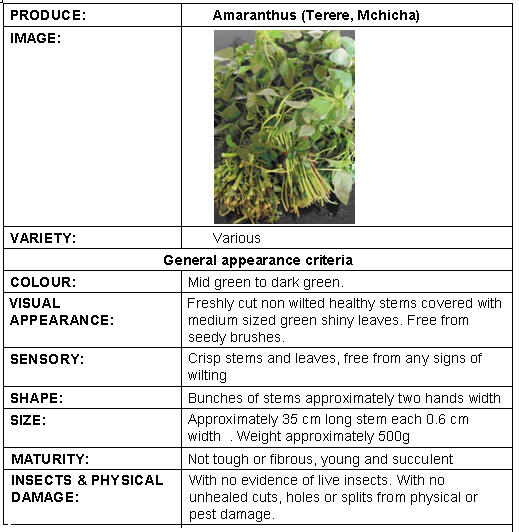 |
| © S. Kahumbu, Kenya |
Information on Pests
Amaranth is susceptible to damage by foliar insects such as leafminers, leafroller caterpillars, cutworms, aphids, flea beetles, and mites.An effective method of controlling insect pests is to cover the bed with a fine screen or nylon mesh netting (32-mesh or finer) (AVRDC, 2011).
| Aphids are a major pest, causing leaves to curl and become unattractive to customers. Aphids feed by sucking plant sap. Small aphid populations may be relatively harmless, but heavily infested plants usually have wrinkled leaves, stunted growth and deformed seeds. Plants, in particular young plants, may dry out and die under heavy aphid attack. Heavy attack on older plants may cause crop loss by decreasing flower and seed production. Damage may also reduce seed viability. What to do:
|
| Cutworms attack young seedlings. First instars are 7-12mm, fully grown caterpillars are 3.5-5 cm long. The caterpillar emerges from the soil at night, encircles the plant with its body and cut through the stem of young plants just above ground level. They may also damage the plants underground. Cutworm damage causes plants to wilt and die. Cutworm damage is usually minor and does not normally warrant control. However, in severe outbreaks a young crop may be destroyed. What to do:
|
| Leafminers (Liriomyza spp.) are small flies, 1.3-1.6 mm in length. The maggot makes long, slender, white mines (tunnels) in leaves. Severely mined leaves may turn yellow and drop. Severely attacked seedlings are stunted and may eventually die. Control measures are necessary when attack is severe, especially on young plants. What to do:
|
| Spider mites (Tetranychus spp., Mononychellus spp., Oligonychus spp.) Spider mites feeding on plants may cause reduction in plant growth, flowering, and number of seeds. Damage is most severe when mites attack young plants. Mite damage may be particularly severe during the dry season. What to do:
|
| Several species of weevils feed on amaranth. Adult weevils feed on leaves, but the larvae (grubs) are more damaging because they bore into roots and stems, causing rotting and potentially lodging and predisposition to diseases. Stem-boring weevils such as the pigweed weevil (Hypolixus haerens) are the most damaging causing plants to wither and lodge. The adult weevil lays its eggs in branch crotches, and the larvae bore through stems to the root collar hollowing the stems. Feeding by larvae results in stems that are more susceptible to wind breakage, thus increasing crop losses. The larvae pupate in the stem. In South Africa, attack by this weevil has been associated with extensive tissue discolouration, decay and cankers in branches, stems, and root collars of Amaranthus hybridus. This weevil has been found to be associated with fungi (mainly Fusarium spp) that cause tissue decay and a canker disease (Blodgett et al., 2004). What to do:
|
| Bugs can cause severe damage to flowering head and seeds, and may be particularly damaging to grain amaranth when present in large numbers during the critical seed fill stage. They are usually of minor importance in vegetable amaranth, and no control measures are needed. What to do:
|
Information on Diseases
Damping-off caused by Pythium may occur when the seed-bed is too wet. Wet rot (also called Choanephora rot or blight) caused by Choanephora cucurbitarum and some other fungal diseases (Alternaria, Cercospora, Phoma, Rhizoctonia) may cause problems. The crop is more susceptible to these diseases under humid conditions, high plant density and high doses of nitrogen. Plant parasitic nematodes are reported to occur but are not a serious problem.See detailled information below.
| Damping-off diseases (Pythium spp. Rhizoctonia solani ) The disease is caused by Pythium aphanidermatum, Rhizoctonia solani and Aphanomyces sp. Seeds may rot in the soil before emergence (pre-emergence damping-off) or seedlings may exhibit stem canker above the soil line and/or root necrosis. Affected seedlings eventually wilt (post-emergence damping-off). The disease is favoured by high soil water content and low soil temperatures. Also dense planting without sufficient aeration enhances disease development. What to do:
|
| Choanephora blight (also called Choanephora rot) is caused by fungus Choanephora cucurbitarium. It causes wet rot of stems and leaves. Affected plant parts have hairy appearance (silk-like threads) consisting of fungal spores. Infection is predisposed by injuries. During rainy season it can cause heavy defoliation. The disease is spread by air currents and infected seeds. Warm, moist conditions favour disease development. What to do:
|
Information Source Links
- Amaranth (Amaranthus spp.) Gobal Facilitation Unit for Underutilized Species- Enabling deployment of underutilized species. www.underutilized-species.org
- Blodgett, J. T., Swart, W. J. and Louw, S. (2004). Identification of Fungi and Fungal Pathogens Associated with Hypolixus haerens and Decayed and Cankered Stems of Amaranthus hybridus. Plant Disease, Volume 88,(4): 333-337. www.apsjournals.apsnet.org
- CABI Geomap www.cabi.org
- Ebert, A.W. ; Wu, T.H. ; Wang, S.T. (2011). AVRDC International cooperators' guide: Vegetable amaranth (Amaranthus L.). www.avrdc.org
- EcoPort - The Consilience Engine. www.ecoport.org
- Keller, G.B. (2004). African nightshade, eggplant, spiderflower Production and consumption of traditional vegetables in Tanzania from the farmers point of view. Master thesis. Institut für Pflanzenbau in den Tropen und Subtropen. Georg-August Universität Göttingen, Fakultät für Agrarwissenschaften. www.underutilized-species.org
- NATIONAL RESEARCH COUNCIL Division on Policy and Global Affairs Development, Security, and Cooperation.
- Nutrition Data www.nutritiondata.com.
- Ouma, M.A. Indigenous vegetable production and utilization in Suba district, Kenya: Improving health, unlocking the wealth in Suba district. BioVision - T.T.U, ICIPE. Unpublished.
- Savala, C.E.N., Omare, M.N. and Woomer, P.L. (Eds.). 2003. Organic Resource Management in Kenya: Perspectives and Guidelines. Forum for Organic Resource Management and Agricultural Technologies, Nairobi, Kenya. 184 pp
- Stallknecht, G.F. and Schulz-Schaeffer, J.R. (1993). Amaranth rediscovered. p. 211-218. In: J. Janick and J.E. Simon (Eds.), New crops. Wiley, New York
Contact Information
- Corner Shop Nairobi:cornershop@africaonline.co.ke, +254 (0) 0716 905 486, (20) 2712268/9
- Green Dreams: info@organic.co.ke +254 (0) 724 781 971/ 0722 562 717001
- Kalimoni Greens: www.kalimonigreens.com , +254 (0) 708 278 273
- Karen Provision Stores:kps@nbi.ispkenya.com +254 20 882 252, 0736 371 437
- Muthaiga Green Grocers, Nairobi
- Uchumi Supermarket: info@uchumi.com +254 20 8020081 - 5, 0733 410 028,
- Zuchinni Green Grocers, Nairobi: +254 (20) 2215067
- Katumani Research Centre, KALRO (kalro.katumani@kalro.org; +254 (0) 710 906 600).
Reference Addresses
1. Achigan-Dako, E.G., Sogbohossou, O.E., & Maundu, P. (2014). Current knowledge on Amaranthus spp.: resear bch avenues for improved nutritional value and yield in leafy amaranths in sub-Saharan Africa. Euphytica, 197, 303-317.
2. Achigan-Dako, Enoch & M.W, Pasquini & Komlan, Françoise & N'Danikou, Sognigbé & Dansi, Alexandre & Ambrose-Oji, Bianca. (2010). Traditional Vegetables in Benin. 10.13140/RG.2.1.1803.1121
3. Adhikary, Dinesh. (2015). Morphologic and Taxonomic Analysis of the Weedy and Cultivated Amaranthus hybridus Species Complex. Systematic Botany. 40. 10.1600/036364415X688376.
4. Agong, S.G., (2006). Amaranthus caudatus L. [Internet] Record from PROTA4U. Brink, M. & Belay, G. (Editors). PROTA (Plant Resources of Tropical Africa / Ressources végétales de l’Afrique tropicale), Wageningen, Netherlands. <http://www.prota4u.org/search.asp>. Accessed 14 October 2021.
5. Ama T. Opare, (2016).Mchicha-Tanzanian spinach and peanut curry. Food for the soul.https://www.theafricangourmet.com/2015/01/classic-bondwe-wild-spinach-vegetable.html
6. AVRDC & IPGRI (2006). African Leafy vegetables. Markets and Gardening practices. Unpublished.
7. Chagomoka T, Kamga R, Tenkouano A, Mecozzi M. (2014). Traditional Vegetables: Recipes from Cameroon. AVRDC – The World Vegetable Center. Shanhua, Taiwan. Publication 14-779. 57 p.
8. Chweya, J.A.; Eyzaguirre, P.B. (eds.) (1999) The biodiversity of traditional leafy vegetables. 182 p. ISBN: 978-92-9043-404-7, ISBN: 92-9043-404-X. https://www.bioversityinternational.org/e-library/publications/detail/the-biodiversity-of-traditional-leafy-vegetables/
9. ColPlantA (2021). "ColPlantA. Facilitated by the Royal Botanic Gardens, Kew. Published on the Internet; http://www.colplanta.org"
10. Ebert, A.W; Wu, T.H. ;T.H., Wang, S.T. (2011). AVRDC International cooperators' guide: Vegetable amaranth (Amaranthus L.). www.avrdc.org
11. FAO/Government of Kenya. 2018. Kenya Food Composition Tables. Nairobi, 254 pp. http://www.fao.org/3/I9120EN/i9120en.pdf
12. Feedipedia, a programme by INRAE, CIRAD, AFZ and FAO. https://www.feedipedia.org/node/187 Last updated on July 28, 2021, 12:10
13. Grebben GJH. Plant Resources of Tropical Africa 2. Vegetables. PROTA Foundation, Wageningen, Netherlands/Backhuys Publishers, Leiden, Netherlands/ CTA, Wageningen, Netherlands. pp. 63-76.
14. Grubben and Denton, 2004). Amaranthus blitum L. [Internet] Record from PROTA4U. Grubben, G.J.H. & Denton, O.A. (Editors). PROTA (Plant Resources of Tropical Africa / Ressources végétales de l’Afrique tropicale), Wageningen, Netherlands. <http://www.prota4u.org/search.asp>. Accessed 12 October 2021.
15. Grubben and Denton, 2004). Amaranthus dubius Mart. ex Thell. [Internet] Record from PROTA4U. Grubben, G.J.H. & Denton, O.A. (Editors). PROTA (Plant Resources of Tropical Africa / Ressources végétales de l’Afrique tropicale), Wageningen, Netherlands. <http://www.prota4u.org/search.asp>. Accessed 13 October 2021.
16. Heuzé V., Tran G., Giger-Reverdin S., Lebas F., 2021. Wild Amaranth (Amaranthus graecizans).
17. Hyde, M.A., Wursten, B.T., Ballings, P. & Coates Palgrave, M. (2021). Flora of Zimbabwe: Species information: Amaranthus lividus subsp. polygonoides. https://www.zimbabweflora.co.zw/speciesdata/species.php?species_id=122180, retrieved October 17 2021
18. IPGRI (2006). Cookbook for traditional vegetables Unpublished
19. Jansen Van Rensburg, W.S., Van Averbeke, W., Slabbert, R., Faber, M., Vanjaarsveld, P., Van Heerden, I., Wenhold, F. & Oelofse, A. (2007). African leafy vegetables in South Africa. Water SA Vol. 33, No. 3 (Special edition). (Available at websites http:/www.wrc.org.za.).
20. Jansen, P.C.M., (2004). Amaranthus spinosus L. [Internet] Record from PROTA4U. Grubben, G.J.H. & Denton, O.A. (Editors). PROTA (Plant Resources of Tropical Africa / Ressources végétales de l’Afrique tropicale), Wageningen, Netherlands. <http://www.prota4u.org/search.asp>. Accessed 14 October 2021.Revision Comment.
21. Magali M,, 2020.AmaranthM,, 2020.Amaranth leaves (Biteku teku) stew recipe. Blue fufu.https://thebluefufu.com/amaranth-leaves-biteku-teku-stew-recipe/
22. Maundu, P. M.; Grubben, G. J. H., (2004). Amaranthus graecizans L. Record from PROTA4U, Grubben, G.J.H. & Denton, O.A. (Eds.). PROTA (Plant Resources of Tropical Africa), Wageningen, The Netherlands.
23. Maundu, P., Achigan-Dako, E., & Morimoto, Y. (2009). Biodiversity of African vegetables. In Charlie M. Shackleton, Margaret W. Pasquini, & Axel W. Drescher (Eds.), African indigenous vegetables in urban agriculture (pp. 65-104). London: Earthscan. https://hdl.handle.net/10568/76872
24. Maundu, P.M., Ngugi, G.W. and Kabuye, C.H.S. (1999a). Traditional Food Plants in Kenya. Kenya Resource Centre for Indigenous Knowledge. National Museums of Kenya, Nairobi. 270 pp.
25. Mziray RS, Imungi JK, Karuri EG (2001) Nutrient and antinutrient in contents of raw and cooked Amaranthus hybridus. Ecol Food Nutr 40(1):53–65
26. Renards G ,, (2020) Shoko (Beef and Alefu stew).196 flavors https://www.196flavors.com/ghana-shoko/ stir the vegetables. Cook for (3-5minutes)
27. Rensburg, W.S., Venter, S.L., Netshiluvhi, T.R., Heever, E.V., Vorster, H.J., Ronde, J.A., & Bornman, C.H. (2004). Role of indigenous leafy vegetables in combating hunger and malnutrition. South African Journal of Botany, 70, 52-59.
28. Savala, C.E.N., Omare, M.N. and Woomer, P.L. (Eds.). (2003). Organic Resource Management in Kenya: Perspectives and Guidelines. Forum for Organic Resource Management and Agricultural Technologies, Nairobi, Kenya. 184 pp.
29. Schippers, R.R. (2000) African Indigenous Vegetables. An Overview of the Cultivated Species. Natural Resources Institute/ACP-EU Technical Centre for Agricultural and Rural Cooperation, Chatham, 214.
30. Tropical Plants Database, Ken Fern. tropical.theferns.info. 2021-11-05. <tropical.theferns.info/viewtropical.php?id=Amaranthus+hybridus>
31. Trucco F., Tranel P.J. (2011) Amaranthus. In: Kole C. (eds) Wild Crop Relatives: Genomic and Breeding Resources. Springer, Berlin, Heidelberg. https://doi.org/10.1007/978-3-642-20450-0_2
32. Wolosik, Katarzyna & Markowska, Agnieszka. (2019). Amaranthus Cruentus Taxonomy, Botanical Description, and Review of its Seed Chemical Composition. Natural Product Communications. 14. 1934578X1984414. 10.1177/1934578X19844141.

